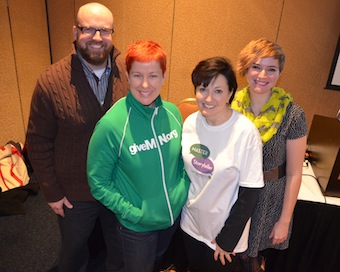Last week I attended the NTEN’s Nonprofit Technology Conference in Minneapolis. It’s a fun and “techy” conference for nonprofit professionals. As part of the conference I delivered a breakout session with Lars Leafblad founder of Pollen, Jamie Millard founder of Paper Darts, and Dana Nelson, Executive Director of GiveMN.

From left to right: Lars Leafblad, Dana Nelson, me, and Jamie Millard
A week or so before the conference NTEN blog ran a guest post from Jamie and I about our topic Ctrl+Alt+Delete: Rebooting Your Digital Community Building.
Here’s some of what we had to say:
When it comes to building community and increasing brand awareness, some organizations hire communications, marketing, and engagement staff to handle these activities. And that makes sense — someone needs to be charged with keeping a close eye on the organization’s community growth.
But building awareness for your important work in an increasingly cluttered space can’t be the responsibility of just one person or even a department. When an organization embraces the culture of creating and empowering all staff to become “brand ambassadors,” authentic and exponential growth starts to happen.
This isn’t a new concept. Most organizations incorporate messaging training as part of the new hire process and encourage employees to “represent” when they are out and about at professional networking events.
However, when it comes to building communities online, often the first place an organization starts is with social networking accounts — creating organizational Twitter and Facebook accounts. And while yes, these are terrific tools, are they really the most authentic and engaging way to build communities behind the facade of an unknown institutional logo?
Read the rest of the post here, on the NTEN blog
Our breakout session generated some terrific discussion about taking a new look at building online communities. You can read some of the tweets that were generated during our session here:
At the session we discussed five key best practices for building or re-building your digital community:
Scalability – Make it easy for others to participate & share your messages. Use templates, sample language for social media, even share your logos.
Creativity – Create a buzz by grabbing attention with fun or unique ways of sharing your messages.
Urgency – Create a sense of urgency by having a specific “window of time” to be engaged, forward on your message, make a contribution, sign up for something.
Leadership Engagement – Get the whole team involved. Even your Executive Director or your non-techy board members. But have a plan and provide metrics about the benefits of becoming more social media savvy, and provide training and then more training to get people comfortable with using new tools.
Amplification effect – Explain and show the difference between just one voice using your organization’s logo to a whole team of voices talking about your great work, events and inviting others to participate.
Here is the SlideShare link to the slides from our session:






